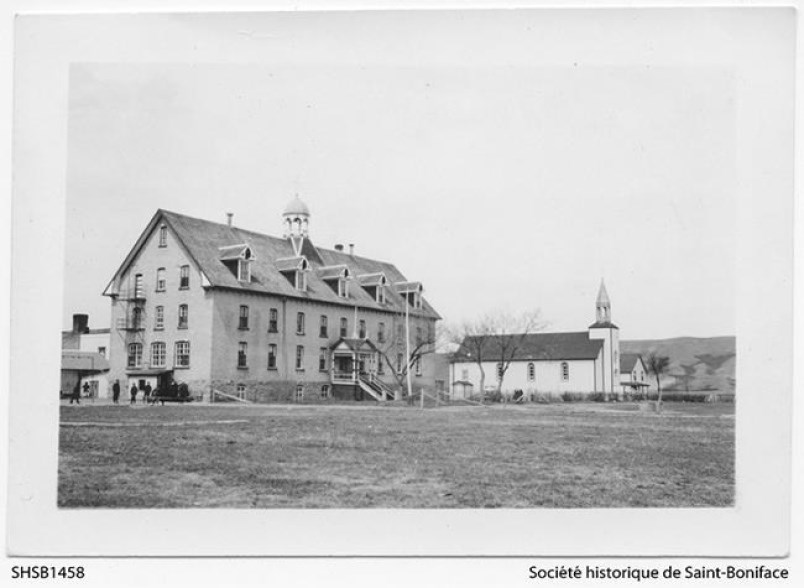Warning: This story involves a topic that some readers may find distressing. If you are feeling triggered, please contact the National Indian Residential School Crisis Hotline at 1-866-925-4419 or the Treaty 4 support line for southern Saskatchewan at 1-306-522-7494.
REGINA — Cowessess First Nation shared the discovery of over 600 unmarked graves near the former site of the area’s residential school, with Chief Cadmus Delorme saying that headstones previously marking the graves had been removed by the Roman Catholic Church several decades ago.
“We didn’t remove these headstones. Removing headstones is a crime in this country, and we are treating this like a crime scene,” said Delorme.
Marieval Indian Residential School was operated by the Roman Catholic Church from 1899 until 1981, when Cowessess First Nation took over. The school was officially closed in 1997, and the building controversially demolished in 1999.
The Roman Catholic Archdiocese of Regina confirmed that in the 1960s, a priest serving in the region had “bulldozed several grave markers” during a dispute with the Cowessess chief “in a way that we all find entirely reprehensible.”
“I know that apologies seem a very small step as the weight of past suffering comes into greater light, but I extend that apology again, and pledge to do what we can to turn that apology into meaningful concrete acts,” said Archbishop Don Bolen, in a letter to the current Cowessess chief regarding the announcement.
The unmarked sites have since been discovered by Saskatchewan Polytechnic experts working with Cowessess First Nation, using ground-penetrating radar earlier this month.
Investigators noted a total of 751 hits at the Cowessess site, which amounts to at least 600 unconfirmed sites after a margin of error is taken into account.
“We can’t confirm if there is more than one [individual buried] under that hit,” said Delorme. “So we want to make sure, when we tell our story, that we’re not trying to make numbers sound bigger than they are.”
Other sites on Cowessess First Nation have been identified by oral knowledge as potential burial sites, said Delorme, as unbaptized babies and non-Catholic individuals would have been buried elsewhere.
Those who attended Marieval were likely from Treaty Two and Treaty Four territories, confirmed Delorme, which includes parts of southeastern Saskatchewan and southwestern Manitoba.
“Unmarked” a repeating adjective in residential site exploration efforts
Unmarked burials have also been identified at several other former residential school sites in Saskatchewan, including the site at Cowessess First Nation.
So far, 35 unmarked graves have been identified at Muscowequan Indian Residential School, with more expected to be found as exploration continues.
The remains of approximately 40 Indigenous children were also discovered on the grounds of the former Regina Industrial School in 2014, which had been sold to a private owner and only recently explored by researchers.
Okanese First Nation has also shared that unmarked burial sites from File Hills Indian Residential School are present on reservation land, and the cemetery space used by the Battlefords Industrial School was notably unmarked in comparison to the portion dedicated to church clergy.
A representative from the Archdiocese of Regina said that often records of why grave markers were removed or omitted entirely are difficult to pinpoint, as these sites were operated independently by clergy members.
The Federation of Sovereign Indigenous Nations (FSIN) has also identified other potential sites of former residential schools that should be investigated for unmarked burials, including St. Anthony’s, Beauval, Lebret and Guy Indian Residential Schools.
Experts have also noted that continued searches for unmarked burials may be difficult, as many former residential schools sites have been sold to private landowners or are now located underneath agricultural fields.
The National Truth and Reconciliation Committee said that an estimated 150,000 First Nations, Inuit and Métis children attended residential schools, with 20 residential school sites operating in Saskatchewan between the 1880s and 1990s.
Estimation shows that more than 4,000 children died while at these institutions, although experts say the true number is likely much higher due to inconsistent record keeping and a string of record destruction in the 1930s and 40s.
Cowessess planning to replace grave markers
The community of Cowessess First Nation will not be leaving these graves unmarked, promised Delorme during the announcement.
The next steps, said Delorme, will be to consult known burial records and work to identify the individuals buried in these unmarked sites.
The community hopes to place grave markers on as many of the graves as they can, and erect a memorial monument in the area to commemorate those resting there.
Delorme said the process will be painful for many, as it will draw out trauma experienced at Marieval and other residential schools in Saskatchewan, but it will also be necessary for the community’s healing process.
“We want to honour our loved ones that lay there today. We want to make sure we keep that place and preserve it, so many can come here and heal,” said Delorme.
The bishop was unavailable for comment before the time of publishing, but states in his letter that the Archdiocese of Regina will work with Cowessess First Nation in obtaining information about those buried at the site.
Part of that support will also be provided in the form of a $70,000 investment to upgrade the cemetery site, pledged by the archdiocese in 2019.
The funding will be used for aesthetic upgrades, including trees and fences, as well as for identifying graves, creating a map of the site and building a central monument.



